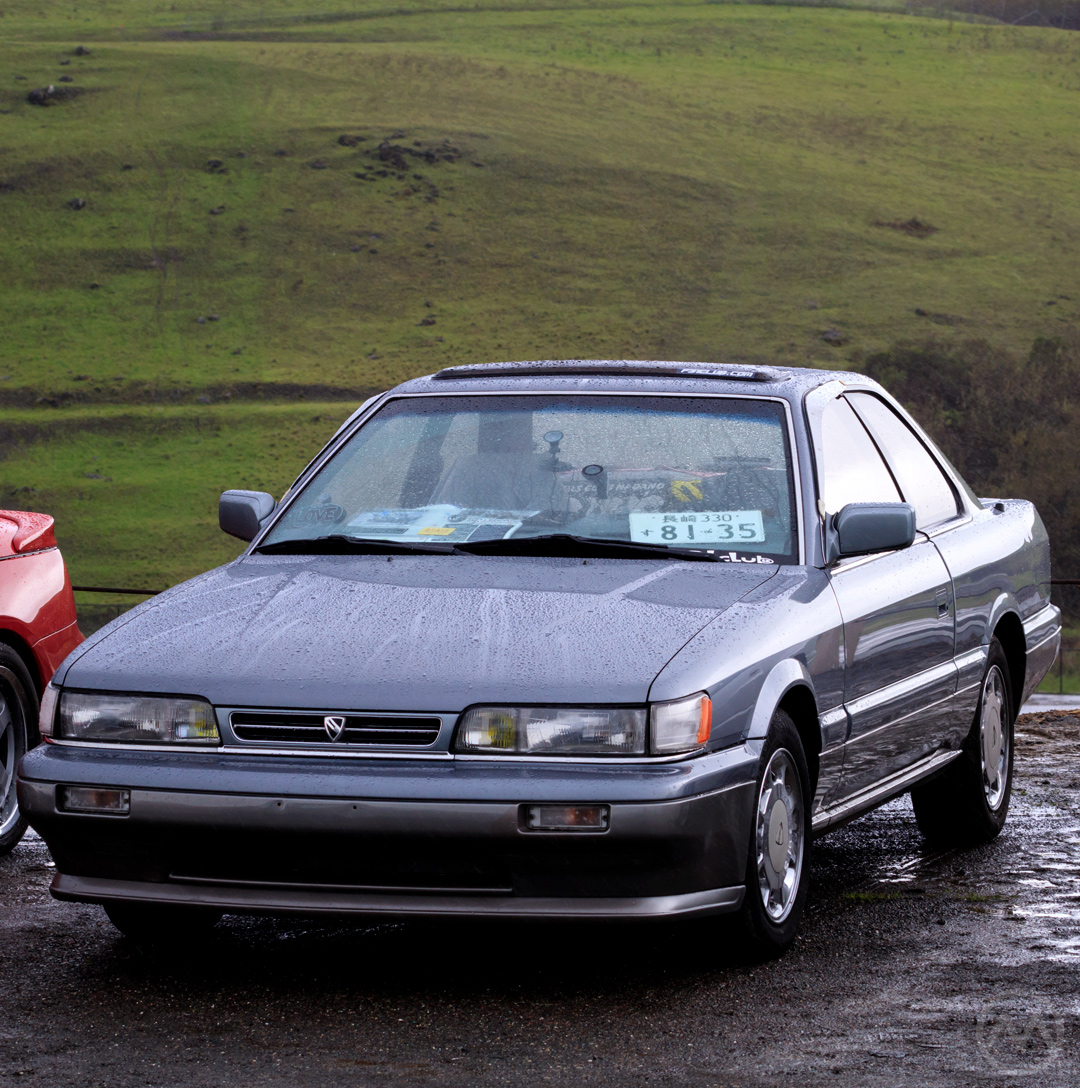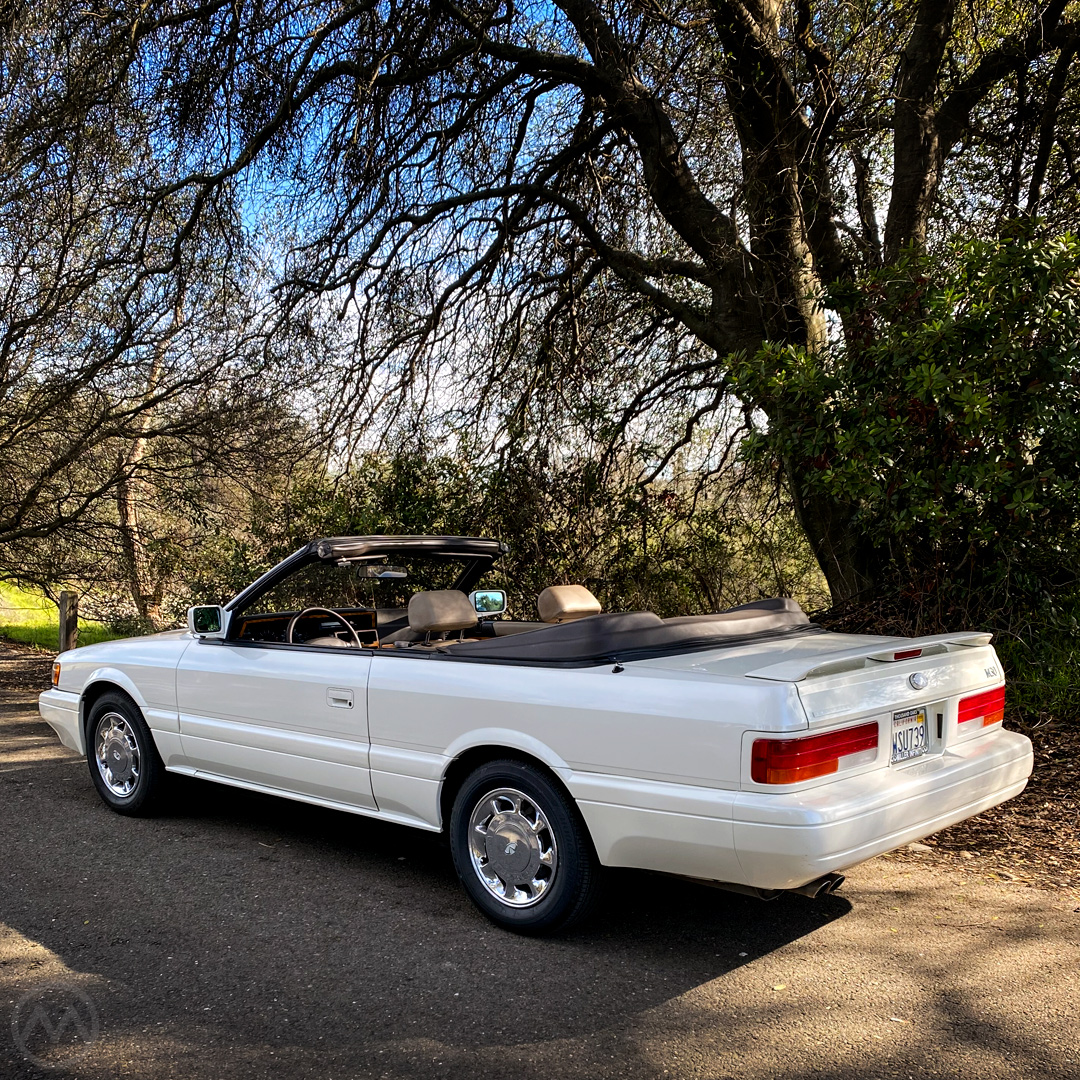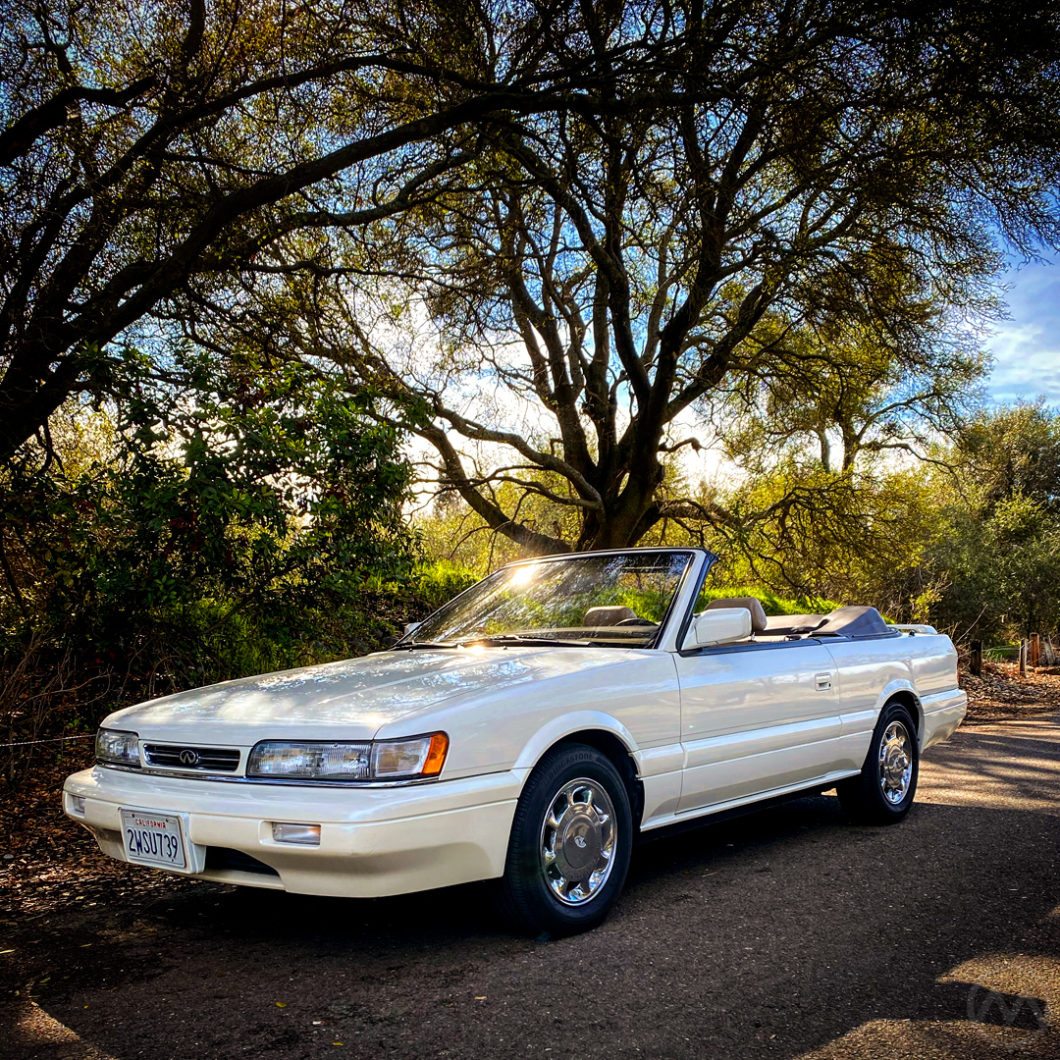It was new to Americans, but the Infiniti M30 was almost half a decade old when it first appeared in what were then brand new Infiniti showrooms in 1990. Baseball-loving Japanese would refer to the M30 as a “utility infielder” – it had a role to play in filling out Infiniti’s lineup and still has a cult of fans, but ended up as a footnote in the company’s history.
The car was actually born in 1986 as the F31 Nissan Leopard, the second generation of a car aimed at Toyota’s Chaser and Soarer – two arch rivals in the highly stratified Japanese domestic market (JDM). It was never as successful as the Soarer but it had many loyal fans.
The car’s journey to American shores, and then to American Sunroof Corporation for conversion into a convertible started nearly a decade earlier – before the F31 was even designed.
After the Reagan and Zenkō Suzuki administrations had reached an agreement for “Voluntary Export Restraints” in 1981, Japanese car imports to the USA were limited by quotas. That didn’t reduce demand for the products, but it did demonstrate that Americans were willing to queue up and pay more for them.
That touched off two phenomena. The first was a wave of factory-building projects in the United States, which would circumvent quotas and also insulate against currency swings. The second was the creation of de facto premium brands from Japanese manufacturers specifically aimed at Americans.
American perceptions of Japanese cars in the early 1980s were still centered around cheap economy cars. It seems almost impossible to believe today, but for that reason, Honda, Nissan, and Toyota begat Acura, Infiniti, and Lexus to separate these cars from the regular brands. None of these brands were offered in Japan until many years later.
Both Nissan’s Infiniti and Toyota’s Lexus were launched in 1989 after years of planning – and both debuted with all-new, all-out luxury sedans – Infiniti’s H50-series Q45 and Lexus’ LS400 – aimed squarely at the Mercedes W126.
But you can’t fill a showroom for a new, unproven brand with just one model. Both companies needed a cheaper, second-tier car. Lexus’ answer was the Camry-based ES250 sedan, Infiniti’s was the M30. For cost and time reasons, both drew on JDM cars that were already on hand – Toyota’s Camry Prominent and Nissan’s Leopard.
The F31 Leopard
Japan’s home market has long been highly segmented – with a vast array of models from larger manufacturers to suit almost every taste, often sold in different channels even within a single manufacturer. The original Leopard was introduced in the fall of 1980 and sold across two of Nissan’s channels – sedans were for the Nissan Bluebird store and coupes were for the Nissan Motor Store.
Developed concurrently with the R30 Skyline, the first Leopard was meant to be a cross between a personal/luxury car and a car with sporty pretensions like the Skyline and it shared most of the Skyline’s architecture. Like that car, it was developed under the watchful eye of Shinichiro Sakurai, a Prince veteran and longtime guardian of the Skyline’s evolution dating back to the 1960s.
Although developed as a sedan and a coupe, it was the Coupe that Nissan seemed most interested in. The company hadn’t considered the Cedric, Gloria, and Laurel coupes successful enough as personal/luxury cars – perhaps because they looked a bit old fashioned, so the Leopard coupe replaced all three and looked far more modern.

Around the same time the Leopard first appeared, Toyota showed what became the first-generation Soarer as a lightly disguised concept car. It arrived a few months after the Leopard went on sale and replaced Toyota’s Mark II coupe. As at Nissan it would also eventually replace the larger and more traditional Crown Coupe.
Like the Leopard coupe, the Soarer was a specific personal/luxury car – although readers who think of Chrysler Cordobas when they hear that term would probably not find them to be quite that sort of car. They were affordable luxury coupes but the emphasis – as with so many things in Japan in the 1980s – was on technology, not chrome, fake wood, or opera windows.
Both the Soarer and the Leopard would come with an enormous range of technological toys including integrated TV screens over the course of the 1980s. Because they were luxury sports cars, they often came with then truly cutting edge features like electronically adjustable suspensions, onboard diagnostic systems, keyless entry, CD players – all pretty wild stuff in the mid eighties.
The original Z10 Soarer came second (though it also bowed in 1980 as a concept car), but definitely won the critical and sales races – it was Japan’s car of the year in 1981 and became the choice for up-and-coming young buyers who wanted a car that was flashy, fast, and reliable.
When it came time to redesign the Leopard, the second-generation car was to be closely tied to what buyers liked about the Soarer. Though nobody claimed credit for the styling (we’ll get to a possible reason why in a moment), the F31 was again tied to the Skyline’s chassis, now in the hands of Naganori Ito, Sakurai’s successor, and being developed as the R31.
By the mid-1980s Nissan had been a very conservative company for a long time, and power struggles between company boss Takashi Ishihara and union leader Ichiro Shioj played out like a Shakespearean drama behind the scenes. Nissan executives took few risks, and its products seemed behind as a result.
In 1984, Ishihara passed the reins to Yutaka Kume, who reinvigorated Nissan in the late 1980s by giving designers and product planners far more freedom. But that came a little too late for the F31 Leopard, which was mostly locked down by 1985.
That year at the Tokyo show, Nissan showed off the wild MID-4 and the postmodern Be-1, both of which broke far more ground than the very conservative F31 Leopard, which debuted just a few months later in early 1986. The Leopard was a handsome car but with later Nissan designs (Figaro, R32 Skyline, Z32 Fairlady Z) getting a great deal of attention, the F31 seemed to get lost in the shuffle.
The Soarer was also redesigned in early 1986 and the cars’ positions didn’t seem to change – the Soarer just sold better. But the F31 Leopard had a great deal to offer.
The Skyline-based chassis gave the F31 good handling and it could be had with Nissan’s DUET-SS “sonar suspension,” and early active suspension system aimed at smoothing out bumps. The car could eat up long trips without leaving the driver fatigued.
All versions were powered by Nissan’s VG-series sixes, three kinds of tax-friendly 2-liters and a pair of 3-liters at different times. There was even a very rare Nismo version, loaded with every possible toy.

The car was best known in Japan as a secondary character in the Japanese TV drama Abunai Deka (“Dangerous Detectives”), a major hit in 1986-87 and the kind of Cop show Americans would be very familiar with. The adventures of detectives Takayama and Oshita from the Kanagawa Prefectural Police looked a great deal like a Japanese Starsky & Hutch.
Because it was so overtly square, the F31 got a refresh in 1988 that rounded off the corners a little. Early series cars are referred to as “Zenki” versions, while later ones are “Kouki” (late model) versions.
Inside, the Kouki F31 got a heavily updated interior with a much more rounded and ergonomic dashboard. Under the hood, it finally got a VG30 Turbo with 250hp on tap – the ultimate F31 Leopard. It was around this time that Nissan began seriously working on the Infiniti version.
Nissan Leopard to Infiniti M30
The Leopard’s facelift was done in the summer of 1988, and the Infiniti brand formally broke cover at the 1989 Detroit auto show only six months later. The M30 was already being shown to dealers, but it was the Q45 that got all the attention for much of 1989’s build up to the start of sales that November.
The car was always intended to be a “stopgap,” something to accompany the Q45 until two new planned models – the Primera-based G20 and the next-generation M/Leopard, then in development at NDI in California, could be finished.
Acura’s Legend Coupe, which had found great success, was the inspiration for targeting the coupe market. But the Leopard was designed for Japanese consumers and regulations – it was appreciably narrower inside than the Legend or American competitors like the Cadillac Eldorado and Lincoln MKVII, and of this group, it was by far the most conservative visually.
To remake it for the USA required structural reinforcement in the doors and bigger bumpers, adding weight.
The Leopard was RHD-only, which meant a new dashboard. Rather than remaking the updated 1988+ Leopard dashboard in left hand drive, Nissan chose to create a reworked layout from the R31 Skyline.
This meant a rather rectilinear looking setup with a huge number of buttons, which looked much more dated in 1990 than the one in the JDM Leopard and ended up a constant source of reviewer criticism. The otherwise quite comfy interior seemed to be a little let down by the dash and steering wheel position.

Unlike the Leopard, which could be had with the VG30 Turbo, the U.S. got only one engine – the VG30E, with 162 hp. Though it was often remarked that the VG30E was shared with the Z32 300ZX, this seemed an underwhelming amount of power for the 3,300-lb. M30 – the Legend coupe was lighter, the Lincoln packed a 5.0 V8. The turbo, offered in the 300ZX, would have been a welcome addition.
The M30 may not have been a powerhouse, but it was still a fairly quick car and one with tons of features – though not quite the range of exotica available in Japan. Almost all power equipment was standard including a moonroof, as were things like fog lamps and automatic climate control. CD changers and a car phone were offered as accessories – there were no official “options.”
At about $24,500, it was notably cheaper than most other cars in the segment given all that equipment, and in the first few months it did quite well, accounting for almost half of Infiniti’s volume in the first few months – but it seemed to run out of gas after that.
The first reason for that might have been Infiniti’s oft-criticized “Rocks and Trees” ad campaign which rivaled Calvin Klein’s “Obsession” ads for being completely opaque about what the product actually was. But most of those aired before the M30 arrived.
The real reasons might have been its visual resemblance to the far humbler Nissan Stanza, the growth in popularity of Nissan’s own Maxima (also VG30E powered and $5K cheaper), and the arrival of the second-generation Acura Legend coupe. That latter car was much more expensive, but also much faster and had an established brand.
Infiniti’s first general manager, Bill Bruce, was a former Ford executive before he’d come on board to Nissan. In on the project since the beginning, Bruce later complained that Nissan hadn’t really thought through the full implications of jumping into the American luxury car market.
Bruce was not a fan of “rock and trees” campaign but grudgingly agreed to it on the basis that it would be sufficiently compelling for an entirely new brand. The M30 Convertible was not his idea, but he certainly welcomed it – Infiniti just wasn’t keeping up with Lexus in sales.
With only the two cars to sell, Bruce focused on customer service. The quality of the cars was matched by the follow-through that the original dealers gave customers – Infiniti’s early days were about greatly improving customer expectations.
Still, you need product to sell. For the car’s sophomore season in 1991, Infiniti would create something you couldn’t get anywhere else in the segment – a convertible.
The M30 Convertible
During the early run of the F31 Leopard, private converters in Japan turned a few “Zenki” Leopards into convertibles, and a prototype for a convertible was considered by Nissan, but never materialized. With the M30 struggling to resonate, Nissan contracted American Sunroof Corporation (ASC), builder of many low-production convertibles, to turn the car into a proper convertible.
The design was a collaboration though not an overly complex affair. At the time, ASC was working on presenting Nissan with a retractable hardtop (which Nissan turned down and Mitsubishi eventually picked up). The M30 convertible was fully traditional – Nissan reinforced the chassis to compensate for the loss of the roof, then sent the unfinished cars to ASC’s facility in Rancho Dominguez, California, not far from Long Beach Airport.

The large top and interior were fitted at ASC along with a smaller back seat to make room for the top architecture. The result was a very clean looking convertible, offered in just three colors – black obisidian, white quartz, or burgundy berry.
The M30 convertible, offered in 1991 and 1992 only, did help sales as the coupe began to fade, but it wasn’t a huge hit. The exact number of convertibles built is unknown, but in 1992, the Convertible was selling better than the coupe. At least 3,000 convertibles were made for that model year.
By then, the M30 was in its dotage – the F31 Leopard had an uncommonly long life at seven years in production, and by 1990 all the other R31-based cars had been replaced while the Leopard soldiered on, possibly to accommodate M30 production.
Neither car was ever a huge seller. Although the exact total is unknown, between 13,000 and 17,000 M30s (including convertibles) were made, plus around 38,000 JDM Leopards.
Meanwhile, Nissan had been hard at work on a replacement that was almost totally unlike the outgoing Leopard. The Y32 Leopard, called the Leopard J Ferie in Japan and the Infiniti J30 in the United States, was a curvaceous, Jaguar-like sedan.
Some M30s have been shipped to Japan over the years and similarly in recent times a few F31 Leopards have come stateside – forbidden fruit is always sweetest. If today’s feature isn’t enough for you, we recommend checking out F31club.com.
Special thanks to @IGCarClub and F31 club leader Roger Aba. Today’s feature shows Mark’s white M30 convertible is seen here (they are his pictures), and Roger’s Silver M30, taken in 2019.


Great article! Love the website. Don’t forget to mention this cars most famous pop culture reference, from the movie Three Kings, with George Clooney. It was one of Saddams cars and a punchline throughout the movie!